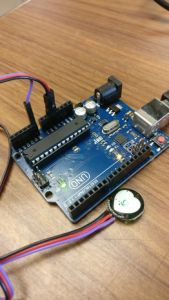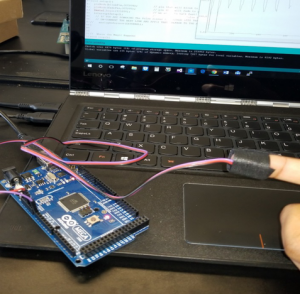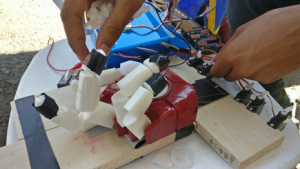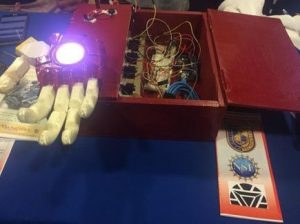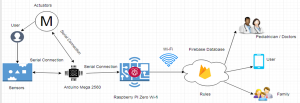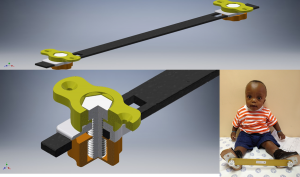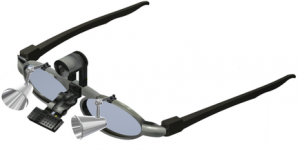MEDICAL DEVICES
(a) Surgical and Medical Instruments
(b) Surgical Appliances and Supplies
(c) Dental Equipment and Supplies
Project Abstract:
(1) Clubfoot Braces
(2) Bionic and Prosthetic Hands
(3) Surgical Loupes
Research Abstracts:
(1) Research on Bio-Signal Signal Processing and Filter Abstract
(2) Arduino Controlled 3D Printed Prosthetic Hand Prototype
(3) Medical IoT Network
(4) Modern Prosthetic Arm
(a) Availability of great job opportunities in the manufacturing sector in general and the medical device industry in particular:
According to the 2013 New York Manufacturers Register, an industrial directory published annually by Manufacturers News Inc. (MNI), New York State is now home to 16,922 manufacturers who employ 733,548 workers. Several manufacturers operating in New York reported expansion over the last year and more companies are moving in. The Brooklyn Navy Yard (BNY) Industrial Park is within ten minutes walking distance from City Tech. The Navy Yard complex is a home for over 300 companies in different fields with tens of them in manufacturing and design. The industrial park is managed by the Brooklyn Navy Yard Development Corporation (BNYDC) which has close ties with City Tech Professional Development Center offering paid internship opportunities to engineering students during the academic year. In addition to that, neighboring states of New Jersey and Connecticut are home for bigger manufacturing corporations (within a radius of 100 miles) such as Johnson and Johnson, Stryker and others. Furthermore, the US. Boston Consulting Group (BCG), a global business strategy firm, predicted in 2011 that within 2011 – 2016, the US is expected to experience a manufacturing renaissance as the wage gap with China shrinks and certain U.S. states become some of the cheapest locations for manufacturing in the developed world. In a more recent report (2013), BCG reported that more than half of executives at manufacturing companies with sales of more than $1 billion plan to return some production to the United States from China or are considering it. Byron Pits reported in his “ CBS 60 Minutes ” TV episode in 2012 that there that there are more than 500,000 jobs in manufacturing waiting to be filled1. Some recent reports estimated the number to be more than 358,000 jobs.
1Three million open jobs but who is qualified? www.cbsnews.com/video/watch/?id=50134943n&tag=contentMain;cbsCarousel
In the medical device industry, the United States remains the largest medical device market in the world with a market size of around $110 billion, and it is expected to reach $133 billion by 2016. The U.S. market value represented about 38 percent of the global medical device market in 2012. There are more than 6,500 medical device companies in the U.S., mostly small and medium-sized enterprises (SMEs). Medical device companies are located throughout the country, the states with the highest number of medical device companies include California, Florida, New York, Pennsylvania, Massachusetts, and Michigan. It is very imperative to see that three of these states are on the east coast of the USA.
(b) Lack of skilled manufacturing technicians especially in the Medical Devices Industry:
Many manufacturers complain of lack of skilled technicians. Employers say they can’t find qualified workers because of “The Skill Gap.” The skill gap refers to graduates’ lack of specific job-related skills necessary to step into an entry level manufacturing position. Almost one third of U.S. manufacturing companies responding to a recent survey say they are suffering from some level of skills shortages. Aerospace and medical devices are suffering the most with a need of 65%[19]. In the medical device industry, more than half of the leading global medical device companies are based in the United States, employing more than 400,000 Americans. It’s also one of the few US manufacturing industries to consistently export more than it imports. However, with all its strengths, the sector faces some serious weaknesses — especially when it comes to human talent. According to a skills gap study by Deloitte Consulting LLP and the Manufacturing Institute, shortages and skill deficiencies in production roles (e.g. machinists, technicians, operators, etc.) are having a significant impact on manufacturers’ ability to expand operations or improve productivity. Moreover, candidates who do possess these skill sets, but have gained them in other industries, such as aerospace or automotive, are often perceived as being unqualified for a related position at a medical device company because they lack specific medical device experience[20]. Additionally, we have noticed that there is no national or regional NSF-ATE center specialized in medical devices.
(c) The need nationwide and worldwide for cheap medical devices especially in developing communities.
According to the World Health Organization (WHO) about 10% of the world’s population (650 Millions) live with disability. UNICEF reported that 30% of the street youth are disabled. According to Helping Hand Relief & Development (international relief organization based in USA) a 0.5% of every population needs prosthetic and orthotic devices. The prosthetic devices life time is 3 years and is much shorter for children. We will work with non-for-profit organizations such as E-Nable the Future Program to design and fabricate custom prosthetic devices that can be used by people with disability . More details will be in the following section.
(1) Research on Bio-Signal Signal Processing and Filter
Abstract:
Abstract:
Many digital signals contain noise in one form or another, that’s only natural for complex streams of information. Digital filters can be used to reduce noise but are less effective for more specialized use cases such as nerve signals. This research focuses on digital signal processing (DSP) as it pertains to bio-signals, which are natural signals sent by the body. The goal of this research is to create a flexible DSP software implementation. A software solution can be extended and adjusted to fit a specific situation. More specifically, the filter is applied in this research to process muscle signals. The flexible filter derived through this research can be applied to future signal research and further aid innovation.
(2) Arduino Controlled 3D Printed Prosthetic Hand Prototype:
Abstract:
There are many amputees in the world, and an increasing demand in efficient prosthetics. Most prosthetics are extremely expensive because they need to be customized to fit each individual. Through the use of muscle sensors and 3d printing, this research aims to create a cost effective prosthetic. Rigid material is used for static components of the hand, whereas more flexible material is used for fingers. In standard prosthetics, sensitivity needs to be adjust per client to fit the strength of each patients nerve signals. By using an Arduino microcontroller, the arm is able to record maximum and minimum signal strength and move the hand accordingly. Finally, the resulting hand is easy to reproduce and reuse in various industries such as education and engineering.
(3) Medical IoT Network:
Abstract:
Fitness trackers have grown in popularity over the past few years, but unfortunately, they lack the vital tracking necessary for most patients. The reason for this is that these fitness trackers are generally marketed towards tech-savy millennials. Due to the young age of the target demographic, developers don’t track health indicators that are relevant to an older generation. Our team has researched which vitals matter to most patients and created a device which can be worn to monitor those vitals. The device uses various sensors to read vitals, such as blood pressure and heart rate, then sends that information to the cloud. Internet connected devices are then able to read that information from the cloud and display it for the user. Client applications created through this research include a website, mobile application, and executable. In the future, this system can be used to quickly implement an IoT monitoring system and quick start new projects.
(4) Modern Prosthetic Arm:
Abstract:
There are many components that go into a prosthetic arm, and with those, just as many concerns. Prosthetic arms need to be strong enough to support the weight of daily activity, but light enough for someone to actually wear. Due to the long list of requirements, cost effective prosthetic arms often have unstable control systems. To create a more efficient prosthetic arm, our research has optimized each component of the prosthetic arm. More expensive prosthetics use various, and costly, solutions to solve this issue. In order to circumvent these issues, our research project uses a casing to limit outside noise which may affect the control system. Along with a casing, the prosthetic uses a digital filter to further reduce noise allowing for extremely smooth and fluid movement. This research will help bring the feeling of a realistic arm closer to amputees, helping bridge the divide and bring forth equality.
- (1) Clubfoot Braces:
ABSTRACT:
According to the World Health Organization (WHO) about 10% of the world’s population (650 Millions) live with disability. UNICEF reported that 30% of the street youth are disabled. According to Helping Hand Relief & Development (international relief organization based in USA) a 0.5% of every population needs prosthetic and orthotic devices. The prosthetic devices life time is 3 years and is much shorter for children, which means additional cost . While people in developed communities can afford sometimes the high cost of medical devices due to support from insurance companies, the people in developing communities can not afford this cost. Thus, the challenge in this project is to explore other options to reduce the cost of these devices. In this presentation we will report the work we try achieving in designing and fabrication for low cost for three devices, to make them affordable for poor people.
Clubfoot is a congenital birth defect that results in the internal rotation of one or both feet. With a new case occurring in every 750 births and over one million untreated cases worldwide, clubfoot is one of the leading causes of disability. Left untreated, clubfoot results in physical deformity and social stigma, which can have detrimental impacts on the quality of life. In this project we are collaborating with Cheshire Home for Rehabilitation of Disable Children Capabilities in Sudan where more than 200 kids attending the center for treatment. Sudan is a developing country in Africa. The center which provides free treatment and supported by the Red Cross can not afford the cost of these plates ($80/each approximately). The goal is to reduce the cost to be below $20 while maintaining the same quality. Two approaches will be used to improve the mechanical properties of the plate:
- Additive Manufacturing: By using state-of-the-art Mark Forged 3D printer which is capable of making composite parts of fiberglass, carbon fiber and kevlar. The ratio of the fiber can be controlled in terms of quantity as well as distribution. With fiberglass 45%, 60% and 85% three different plates were made. Carbon fiber will be explored as well.
- Experimental Methods to develop a low cost composite material: The project is expected to develop fiber-reinforced composites for high strength and lightweight applications. the composite will be prepared using various types of glass and carbon fiber reinforcements into epoxy resin system. The acceptable fabrication procedure includes vacuum bagging, resin infusion and hot press. Allowable Processing temperatures range from room to 160 °C. Fiber volume fraction in these composites will be required to stay within 50-65 vol %.
Students design of a composite reinforced fiber glass plate.
(2) Bionic and Prosthetic Hands:
Abstract:
Bionic hands are very expensive even for people with disability who live in developed countries. The lowest price for a basic bionic hand is $2,500. The goal of this work is to reduce the price to be less than $300. The hand components will be 3D printed using different materials (ABS, PLA, fiberglass, carbon fiber, kevlar…etc). Current estimates obtained for the material cost is about $200 (including Linear actuator, myoeletcric sensor, screws and nuts, gear torque and metal gear digital servo, model material, and micro servo motor). The figure above shows the computer model and the 3D printed model of the hand. Furthermore, we are also working with Enabling the Future (non-profit organization) to prepare low cost prosthetic hands for kids.
(3) Surgical Loupes:
Loupes are very important to reduce surgery errors. They should be equipped with lenses and light beam as an option. Prices vary from $280 – $700 in average. In our design we will use 83% Aluminum 6061, and 17% stainless steel. This will drop the material cost to be below $20. The loupe accessories could be made to be flexible with any frame in order to increase number of users in a developing country. Having the loupes to be less expensive will help in improving the quality of surgeries in developing areas. The figure below shows the suggested model and design.

